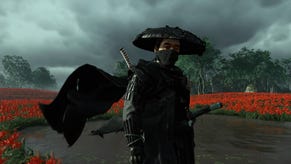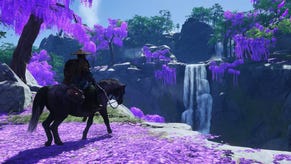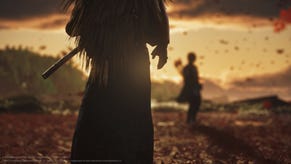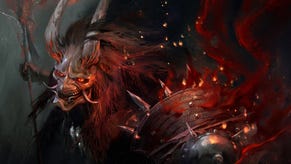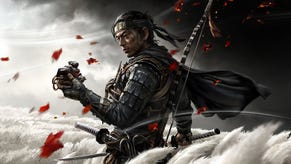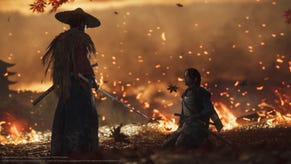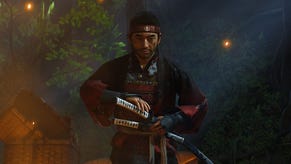Ghost of Tsushima interview: combat, exploration, morality, themes, and the world
In Ghost of Tsushima, “everything moves”.
If Infamous: Second Son was a showcase for what this generation could do with flashy neon lights and pretty particles, Sucker Punch’s next game hopes to make its world feel alive through motion.
Instead of interrupting your adventure with intrusive UI elements, this samurai adventure game lets the wind be your guide. Press a button and the wind shifts, pointing you in the direction of your next objective. The wind blows and the world breathes along with it.
“Grass moves, bushes move, leaves move, birds move,” creative director Jason Connell tells me. “The cloth on your character, and everybody’s character, moves if it can. Hair moves. There’s just this massive undertaking from a technical side, but also the artistry to make it look good. And then implementing a design around that, a mechanic around that as well, that you can kind of control the wind and let it guide you.
“So, all those little details that, you know, ‘Oh my God, the back of his headband moves, or this string of his hair moves with the wind.’ Everything has this motion to it. I’m very proud of that, because I think that is a hard thing to do across an entire game, and the team has done such a great job.”
One of the goals when developing Tsushima was to remove much of the screen clutter that plagues open-world games. The UI is stripped back and dynamic. Your health bar appears when you unsheathe your sword and vanishes when you slide it away, and both of these actions are manually triggered. Sheathe your sword after an encounter and you flick the blood off or wipe it clean across your tunic with a flair.
“If I see a ton of UI on the screen, ugh, I’m just looking at UI,” Connell says. “I want to look at our beautiful game. I want people to be transported, not reading text on the screen.”
When exploring, a UI element pops up in the top left corner of the screen to tell you how far away from your objective you are, and it fades away after ten or so seconds. You call it back by asking the wind to guide you, follow the wind, and focus once again on this world reacting to the elements to guide you on.
Sucker Punch wants to imbue the game with a sense of discovery and exploration. Where Second Son’s horizon was obscured by buildings, here the horizon stretches out in front of you, a sea of grass swaying in the breeze. To make you want to dive in, the developer created what’s called the forestry team and the biome team - these are responsible for making the world varied and distinct.
“Because if you blanket the entire island with the same types of plants and trees everywhere, then it becomes incredibly visually fatiguing over time, right?” Connell asks. “You can’t play an entire game like that. Or you could, it’s just, I don’t think it would be very memorable.
“So, the goal was for those teams to create little pockets of massive boldness and beauty. So, take a golden forest and make it incredibly gold, so you see it across the map. And take a bamboo forest, and don’t make it a tiny bamboo forest - make a massive bamboo forest, so it feels like you remember where the bamboo forest is. There are swamps, giant fields, and areas where there are red flowers everywhere, as far as you can see. We’ve shown snow. So, there are quite a few different biomes to create a visually dynamic experience.”
Another big change from Second Son is the sky - here the sun rises and falls in real-time, where Second Son opted for changing the time of day depending on what chapter you were playing. The clouds roll, the weather changes, and the lighting shifts as the clock ticks on, like in many modern open-world games. But some of the learnings from Second Son did come along for the ride.
“You know, we have a powerhouse particle system because of Infamous,” Connell says. “And when we moved to this game, we’re like, ‘Well, what do we do with our amazing visual effects team?’ Which is a very small team, but they’re very talented. And so, the way that we decided to utilise them, which I think was brilliant on their behalf, is how can we use particles to make the world feel more natural, and more alive?
“So, there are tons of leaves on the ground in some areas where you can kick them up with your feet. That’s a visual effects thing. There are cool blood splatters that happen in the world. There are leaves falling from all kinds of trees, and pampas grass tufts. We even used some particles for some animals that are in the distance, like the birds that are off in the distance, all of that’s particles. So, the particles have taken on new life.”
I can already picture the way embers dance in the night sky as you fight through a flaming fort. And of course, you will dance along with them, too. Ghost of Tsushima’s combat is like a deadly ballet, where each sword swipe can snuff out a life in a geyser of claret.
“One of the challenges of creating a game like this is that, if you’re a samurai fan, or you watch a lot of samurai movies, you know, people die quickly,” Connell explains. “Like, really quick - in some cases, super instant kills, and everybody’s dead before anybody moved a muscle. And so, that’s challenging, because if you just had a game where that was it, then it would be over very quickly.
“So, we want to make sure that you have moments like that, like in standoff, where people die very quickly when they come at you. You’re just still as a statue, and then suddenly you burst out into a flurry of blood and blade.
“Now, the person that played in our combat section [in the State of Play presentation], in the middle of that camp, he is very good at our game. He’s one of our QA testers. He’s played our game for a very long time. He’s probably one of the better players that we have at the studio. And so, that is great, because it shows off this beautiful, elegant, effortlessly pulled off style of fighting, but maybe it was almost too good, because it doesn’t really show him getting hit. If that was me playing, I’d have gotten hit a few times. I’m not as good as he is. And it’s pretty challenging at times. You could potentially get surrounded.”
To perform this dance, you must switch between different stances to combat certain enemy archetypes. You can also parry incoming attacks and dodge - each of which has a window where you can pull off a perfect riposte, slowing time and unleashing a counterattack of your own. Then there’s the ‘Ghost’ aspect of the game, where you can adapt non-traditional tactics that the samurai frown upon, using subterfuge, stealth and cunning to get the upper hand.
“It’s not a binary thing where you turn into the Ghost and you can’t fight like a samurai any more,” Connell says. “It’s augmenting your playstyle. It’s kind of evolving your playstyle. So, that means that you can use some of those Ghost tactics in the middle of fighting as a samurai. If he had a smoke bomb, he could’ve thrown it in the middle of that encampment for the samurai section. He could’ve thrown it down there. So, it’s not like we’re trying to tell you that you can only play one way or the other.”
Players are free to dip into their entire arsenal and find a playstyle that matches their preferences. This is no binary moral choice, and it won’t affect the story if you choose the ‘dishonourable’ path during encounters. You can also back up your preferred style with armour choice, kitting yourself out for battle, stealth, or exploration.
“You can imagine the samurai armour, where it actually has the big Kamakura-era sleeves on the side,” Connell says. “That is going to be more useful for samurai fighting style, and maybe more defensive. You could take a hit, kind of thing. As you progress through the game and you become the Ghost, and you’re wearing the Ghost armour set, then that is going to be more for sneaking around, maybe you’re a little quieter. They can’t hear you sneaking up.
“So, we try to push those playstyles. And there was even another one that we actually showed, which I quite like a lot. He’s wearing it in the opening, the exploration section. So, if you have that one on, that one gives you perks towards exploration, finding things.”
Because of Sucker Punch’s history, many assumed that the samurai and Ghost were your red and blue morality meters - your moral choice and a major decision that affects how the game plays out. This isn’t the case. Ghost of Tsushima has a specific story that it wants to tell. While you are free to choose the odd conversation responses, these are more for flavour than story impact - this isn’t a branching RPG - and everyone will experience the same story, no matter how much of a sneaky bastard they are.
“No, there’s no narrative impact per se by doing specific actions or things like that, especially like what we’ve done in the past with games like Infamous, where that’s kind of the core part of that game,” Connell explains. “In this game, the narrative is the supreme ruler. So, what we’re trying to do is we’re showing a samurai go through a massive transformation, and sacrificing a lot as he evolves into becoming the Ghost.
“Now, as you go through that narrative, that narrative will unlock new ways for Jin to engage with the Mongols, and as he heads more towards becoming the Ghost, he becomes more of this feared legendary warrior. But the goal is really to underline that story of transformation.”
I enjoy a branching story as much as the next person, but I’m glad you’re not punished for engaging with some of the more interesting systems here. Ghost of Tsushima could have risked feeling stale if you found yourself locked into one kind of playstyle. Now you can walk into a camp and call out the enemies for an honourable duel, or creep along the rafters and slip blades into necks as the mood takes you. Or perhaps you’ll blend both of these styles.
Stealth doesn’t play with light and shadow, instead opting for line of sight, verticality, and creeping through the long grass. Ranged weapons, close-range sneak attacks, and gadgets will be your bread and butter for thinning the Mongol ranks.
“There’s no specific mechanic around, you know, playing without the light, or in the shadow, or something like that, but we light things in a way that hopefully creates drama, to where it feels like you don’t want to be standing in the light, because that’s usually where the guys are,” Connell explains. “That’s usually where the Mongols are lurking, or hanging around a campfire. So, by nature of just the way we light the game, and create the game, sticking to those shadows or those rooftops or the grass, as you pointed out, those are the ways that will keep you being able to get the pounce on your enemies.”
That light and darkness is a reflection of the game’s themes, too. But not in a Star Wars or Mass Effect way. There’s no pure good and evil here, just shades of grey - quite literally if you play with the monochromatic filter applied. It’s about perspective and ingrained sense of honour. A man who’s forced to break the code that’s been embedded into him from a young age, to fight an enemy with a different culture.
“I would say that some of the themes that you’re going to experience while playing the main story, I think sacrifice, and what it means to sacrifice something that you hold very dear, for potentially the right choice, the greater good, if you will, I think is a huge theme in Jin’s story,” Connell says.
“I think that it may be hard for people to understand, but obviously the idea of what honour is to somebody, when you’ve been taught your whole life to think a certain way, and then suddenly something challenges that, that’s a theme that you’re going to experience, and you’re going to play with. And then I would say a sense of maybe family and home, and how do those play into each other when a war happens? Those are some of the biggest ones.”
With the wind at my back, I can’t wait to see where Sucker Punch’s latest adventure takes me. Even if we are all just along for the ride.









